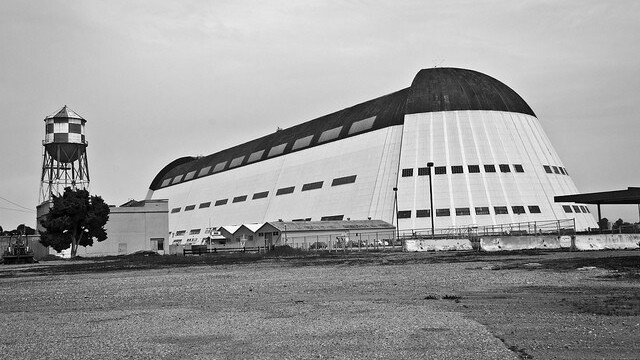
Moffett Field in Sunnyvale, CA. Today it is home to the NASA Aimes Research Center, but it’s the Garden of Eden from which today’s vibrant Silicon Valley startup culture first emerged. Not what you expected? In order to understand how an airstrip lies at the heart of the world’s most dynamic technology hub, it’s important to quickly examine the role of the area’s role in World War II.
The area south of San Francisco, today known as Silicon Valley, was little more than farmland throughout the War years, but there was one man in particular who shaped the outcome of the war and the destiny of this area, Stanford University Dean Frederick Terman.
Terman left his post in the school’s electrical engineering department to oversee a staff of 850 researchers at the Radio Research Lab at Harvard University. And while he was there, he watched as the U.S. government channeled hundreds of millions of dollars to scientists and researchers who were at work on various methods that could outfox Germany’s very sophisticated air defense system. In the end, it was tin foil, dropped by the ton during bombing raids which helped turn the tide in the Allies’ favor. That, friends, is a story for another time. Watch the video below for full details.
Suffice it to say, when Terman returned from Cambridge, MA at the conclusion of World War II, he was determined that Stanford University would become one of the nation’s leading research institutions, and that it would not miss out on government investment in research, as it had during the war. And while “The Good War,” WWII was over, Terman would soon have his chance to show what a powerhouse Stanford could be.
As the Cold War between the United States and the Soviet Union intensified, the escalating game of cat and mouse meant that newer and more advanced technologies were always needed to maintain an advantage. “Basically, the motivation, for Terman and Silicon Valley in the 1950s and 1960s was the Cold War crisis, not profit,” says Steve Blank, a Stanford professor known for his prolific contribution to lean startup methodology. “This country faced a life or death struggle, and it was funding entrepreneurs with military finance,” says Blank.
The real innovation that Terman promoted was a shift in thinking, that students should leave school and start companies of their own, and that professors should serve as advisors and investors. Both William Hewlett and David Packard were students of Terman’s. Computing giant Hewlett-Packard, which bears their name, owes its existence in no small part to Terman’s early encouragement.
And as his students left school and collaborated on new companies, Moffett Field was the intellectual playground where the latest technologies to support the aerospace industry were tested, and eventually incorporated into an increasingly elaborate defense network.
From the NASA Ames website:
As a leader in information technology research with a focus on supercomputing, networking and intelligent systems, Ames conducts the critical R&D and develops the enabling technologies that make NASA missions possible. Ames also is a leader in nanotechnology, fundamental space biology, biotechnology, aerospace and thermal protection systems, and human factors research. Ames research in astrobiology focuses on the effects of gravity on living things, and the nature and distribution of stars, planets and life in the universe.
Stanford University, the University of California at Berkely, and other area institutions played a vital role in developing new technologies, but it was private entrepreneurs whose impact was increasingly felt. “Several companies in what would become Silicon Valley benefited from the ambitious goals and budget largesse of the Apollo space program,” said Dag Spicer, the senior curator of the Computer History Museum, in Mountain View, CA. “The stringent quality and performance requirements of (integrated circuits) for Apollo allowed early semiconductor companies to learn at government (that is, public) expense, a technology that would soon have broad application and whose price would plummet as these companies perfected manufacturing methods.”
But the causes of causal factors of Silicon Valley culture were both large and small. While the urgent need to develop countermeasures to Russia’s nuclear threat spurred military innovation and a litany of companies dealing with national security, a much subtler, but equally powerful force contributed immensely to the dynamism that today defines startup culture: employee equity. Today awarding employees an ownership stake in new companies through shareholder rights is standard practice at a startup. It helps to mitigate the risk that a new venture might go belly up. However this was a relatively new idea.
“I don’t think they realized what the potential upside of this might be,” says Sean Casey, co-founder of the Silicon Valley Space Center, a business league whose purpose is to encourage entrepreneurship in the new space industry. “They were just engineers. They just wanted to do what they love doing, which is engineering.”
Casey says that while significantly more money was held in East Coast banks during the early years of the space program, East Coast financiers and company founders were less excited about carving off a share of potential profits for their employees, and this gave an advantage to Silicon Valley companies. And while many companies died along the way, the wealth created by successful ventures was constantly seeking new homes, giving rise to an early venture capital industry, and angel investing.
Early investors poured their money into aerospace related startups, which ensured that the industry would blossom throughout the Cold War. California had 307 aerospace manufactures in 2008, employing nearly 113,000 people, who earned an average salary of $66,606, according to U.S. Census Bureau data compiled by the Aerospace Industries Association. Today Tech sector employment in California represents 4.4 percent of all jobs in California, according to the Public Policy Institute of California. Looking at figures from the Bureau of Labor Statistics, there were 455,000 people employed in the “information” industry in California in July of 2011.
Get the TNW newsletter
Get the most important tech news in your inbox each week.






